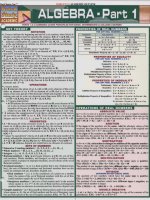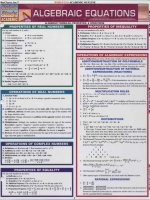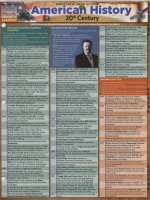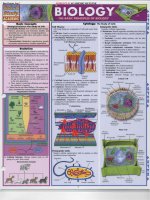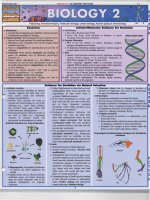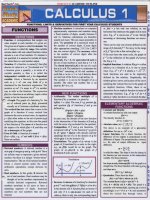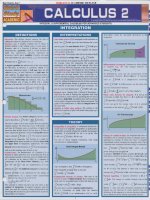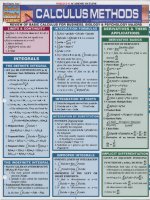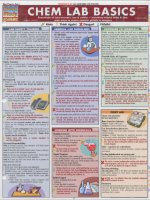Quick study academic calculus 2 600dpi
Bạn đang xem bản rút gọn của tài liệu. Xem và tải ngay bản đầy đủ của tài liệu tại đây (8.83 MB, 4 trang )
DEFINITIONS
INTERPRETATIONS
• !leuristies. The defi nite integral captures the idea of
addin g the va lues or a run clion over a continuulll .
• Riemann sum. A su itably we ig hted sum of values. A
de fin ite illlcgra l is the li mi t ing value of sueh sums. A
Ri e man n s um of a funct ion f de f incd on [II ,h] is
de te rmincd by a partitio n , which is a fini te division of
[{I .h·1 into subintervals, ty p ically exprcssed by
{I =xu
• Area under a cun·e. I ('lis nonnegati ve and cont inuous on
fro m each sub intcrval , say c; fro lll [x; " x ;]. The associated
" i)(Xi - X;
Rie mann sum is: ~f(c
j
d.
I
A regula r pa rtitio n has sub intervals all the samc Icngth,
{\. x =( h ~{I)/II , x ; = {I + i {\'x. A parti ti on 's norm is its
max im um subintc rva l length. A left s um takes the left
e nd poi nt Cj=Xj_, o f each , ubinterval ; a r ight su m , thc
ri ght endpoin t. An uppe r sum of a continuous f takes a
po int <"; in each subint c rva l w here thc max imu m \alue off
is ac hieved; a lowe r sum , thc m in imum val ue . E.g., tl e
uppe r Rie ma nn su m of cos x on [0,3] with a reg ul ar
partitio n of II int cr va ls is the left sum (since the cosine is
decreas ing o n the inte rva ll :
f ICOs(U- I):t)+
I]..:i.
i I
11
Il
A '(x )=f(x ) (valid
endpoints).
[a,h], the n ( >tf ed dx !; ivcs the a rea hetwee n the x-a xi s
• I>
a nd the graph. T he area func tion A (x) =
.c'f (n dl gives
--- -- - - - -- - -..-
A(x)
' 1,
a .(/
x
U
A rough estimatc o f a n integ ral may be made by est ima ting
the ave ra ge va lue ( by in spec tin g th e gra ph ) a nd
multip ly ing it by the le ng th o f the illl erva!' (See M el/II
Ii' /l/I! Theorem (MVT) jiJl" illtegra /s. in the Theon ' sccti on. )
• Accumulated Change. The int egra l of a ra te o f c hange of
a q ua ntity over 3 time interva l gives the tOlal change in th e
q uanti ty over the time inte rva l. E.g., if v (l) =s '(I ) is a
ve locity (the rate o f e ha nge of pos it ion), then v (l )1'lt is the
approxim ate displ acement occ urring in th e time inc re me nt
/ to t +{\./ ; addi ng the di sp lace me nts for all time inc rc m c n.ts
gives the approx imate change in pos ition ovcr the enti re
time inte rva l. In the lim it of small time in crcme nts, o ne
."
gc ts the exac t to ta l di splacement: / v(f) dl =s (h)~-'(IIl .
."
• Differentiation of integrals. r unctions a rc oftcn de fined
a" integra ls. E.g., the "si ne in tegral fu nction" is
Si(x)= ./,:"( Si;l I )d l.
To dirfe re n t iatc s uch, u se t he ' ccon d pa rt of the
fundam ent al theo rem: Si '(x)= sin x /.\'. A fu nction
such
as
( 'f (t)(l/
•a
l 'j (x )dx=
lim ~f( C i)Llsj.
11 .lxll .() i
T he lim it is sa id to cx ist ifsome number S (to be called the
integra l) satis fies the roll ow ing: Every £> 0 admits a 6
such tha t all Riem a nn sums on partitions of [tI ,h] with
norm less than 6 dilTer from S by less than £ . If there is
suc h a valuc S. the I'unct ion is sa id to be int egra ble a nd the
value is de noted
l 'j(x )dx or I f .Thc function must be
(I
(l
bounded to be integra bl e. The fu nction f is ca ll ed the
integrand a nd the points {I a nd h arc called the lo,ver lim it
a nd uppe r li mit o f integralion, respectively. T he word
integral rerers to thc rormation of
ja-I>f
from f and [(I .h], as
\Ve il as to the resuiting value ifl here is one .
• ·\ ntiderhative. A n "ntidc riva tivc of a fi.lI1ction
f is ,[
func ti o n A whose de rivative is f : A'(x )=f(x) for all x in
some do ma in (usua lly a n inter va l) . A ny t'.I'O antiderivati ves
of a fu nctio n o n an in terva l differ by a co nstan t (a
consequence of the Mea n Va lu e T henrem ). E.g. , bot h
J1.. j" j
W dl=
dx "
J1.. A (x ')= A ' (x') 2x = 2.xj(x'1.
2I (x -
a )'- a ll(I iIX "., -
(j .lil-'-'
c rln g
de noted
I--.
(IX
.
a re ant 'd
i c n.
vatlvcs
0f
j)·(x){I (x)dx=/(;)j~b(l (x)Clx.
1
jj(x)dx,' ,s
a lll ide rivatives o n a typica l (often
inten a!' E.g. , ( lo r x < ~ I , or for x > I).
Ml~ ~~ ~~~~~~B""~I~
~---------------------b
a
unspecifi ed )
X- dx =! x ' - 1 + C.
j '!x' - i
Th e consta nt C, w hich may have any real valuc, is the
constant of integr a tion . (Com puter prog ra ms, and this
cha rt . may om it the constant, it being understood by the
kn owledgea hle user that the g iven a nl idcrivative is just one
representative of a ra m ily.)
is f ; and
if (x) ldx.
• Fundamental theorem of calculus. O ne part o f the
theore m is use d to evaluate integrals: Iffis continuo us o n
[(I, h]. a nd A is a n ant idcr iva ti ve off n n th at inte rval , then
j
·"f (x) dx=A(x )I"C= A (b) - A(a).
(,
{/
The other part is used to construct antide rivativcs:
If f is conti nu ous o n [a , h) . th en the fun cti on
A (x)l= ( j U)d l is an a ntiderivative of f on [(I ,h] :
. a
~
b
apprehend or cvaluate. In effect, the "a rea" is smoothly
rcd istributed w it hout changing the integral;' value. !I' g is
a fun ction w ith cont inuous deriva tive andf i, continuous.
then
" lI )dn = ...I'df (.9(f ))g ' (f )dl,
1"f(
where c. d are
points with g (C)= il a nd g(rI )= h.
In pract ice, su bstit !!!r lI = g(l); compu te t11/ = g'(I)dl; and
find what t is when 1/ = 0 and I/ = h. E.g.. I/ =sin t e ffe cts the
transrorm ation
I> ( )
Iff is non negative , then .(".f
x dx is no nnegati ve.
i[ ' j(x )dx i< t
II!I
/ .,'
lnnnunuu : ~ ~
whkh becomes
X - {I ,
an exp ression for the fam ily or
n
integra tion can be cha nged to make an in tegral eas ier to
Use this
in tegra l evalu at ions w ith rough
ove restimates o r u nderes tima tes.
l/.hJ, the n so
,
• Cbange of variable formula. An integrand and limit, of
"
to ch ec k
U
C
is attained
i\1VT for Integra h
L · (b -alS l "f (xldX S, M . (/)- a) .
Iff is int egrablc on
f
somewhere on the inLe rval : -b - -a . a .f(x) dx =.f( ; ).
\ -u- du= I' " "~
! - s in-I co~ I til.
/.",....----,;
of
of
on
·
I
Oil
by 2a-.
I ., T he indefinite in tegra l ora runction!
'
dx
In thc case g - I , the a\eragc value of
• Integrability & inequalities. A co ntinuo us fun cti on o n a
closed inter val is integra bl e. Integ rab ility On [tI .h] imp li es
int egra bi lity on c losed sub inte rva ls of [tI .h]. Ass umin gfi s
in teg rable , if L "'f(x) 5. M for a ll x in [{I ,hJ, th e n
~
IIiII
·Mean value theorem for integrals. Ir f an d ~ a rc
conti nuo us o n [II ,h], then there is a S in [a.h] such Lhat
f«,
L_
in\o l vin g
. a
THEORY
II
c OI11[l osition
A( u )= ( "f (tldt. T o d i frcre nt ia te, u sc the c hai n rule
x~
• Definite integral. The definite inte gra l off frol11 {I to b
may bc described as
is a
and the fundamcn ta l th eorem :
(x )= y ,, + ('fll )d l.
.
-;.o.-.-.--
::;.
- ;.;.
--~
-
Illay bc defined by average VII[lIe = 'h-=- / f(xl dx.
-Integral curve. Imag ine that a run cti on f determines a
slope fix) lor eac h x . Plac ing linc segments w ith s lo pe
fi x) at po ints (x.y) fo r va ri ousy, and doi ng thi s lor va rio us
x , one gets a slope field . A n antidc ri vati ve o ffi s a fu nc tion
whose graph is tange nt to th e slope field at each po int. T he
gra ph o f the a nt ide ri va ti vc is called a n integ ral curve of
the slope fi e ld.
• Solution to initial value problem . The so lution to the
diiTerential eq umiony ' ",/"( x) with initia l va luey(xnl = y" is
3
F unda m e nta l T h e orem
fl.x)
the arca accu lllul ated up to x. Iffis negati ve, the integral
is the negat ive o f the area .
• Average value. The awragc va llie 011 over a n int erval [a ,h]
i
for o ne-si de d de rivatives
."
(l
2
cos ' l dl , si nce ! 1- s in 'l = cos I
for () < 1< 1[/ 2. T he for mul a is ollen used in revcrse,
staJ1ing w ith ], "1-'(.9 (x ))O' Cddx.
ec Technic/iII!s on pg. 2.
• i'atural logarithm . A rigorous defini tion is In x =
(' Ida
. T he change of variable for mula with 11 = I I I
U
. ,
. , ., I
yiel ds ./ ,
/., - I
/., \
a rill = . , I -cc1- d l = - _, . I dt sho\\ ing that
In ( f Ix) = ~I nx. The other elementary propertie, of the
natural log can likewise be easily derived from thi,
definition. in this approach, a n inverse function is deduced
a nd is derined to be the natural exponent ial function .
•,
C
n
INTEGRATION FORMULAS
Other routine integration-by-parts integrands arc arcsinx,
XCOSX, and xe UX ,
• Rational functions . Every rational function may be
written as a polynomial plus a proper rational function
(degrec of numerator less than degree of denominator). A
proper rational function with real coefficients has a partial
fraction decomposition: It can be written as a sum with
each summand being either a constant over a power of a
lincar polynomial or a linear polynomial over a power ofa
quadratic. A factor (X-C)k in the denominator of the
rational function implies there could be summands
Inx. xnInx. xsinx,
• Basic indefinite integrals. Each lormula gives just one
antidcrivativc (all others dillering by a constant from that
given). and is valid on any open interval where the
integrand is defined:
~
1/ !
1
*
J x"dx=~(n
n+l
f 1dx=lnlxl
x
-1)
fe"xdx=e;x(k * O)
feos x dx=sin x
fsin x dx= -cns x
fl'~:' =arctan x
x
f~=81'Csin
Ii-x'
• Further indefinite integrals. The above conventions hold:
J~()t x dx=ln lsin xl
ftan x dx=lnlsec xl
.A.!...+",+~"
x-c
(x-c)"
A factor (x'+bX+C)k (the quadratic not having real roots)
in the dcnominator implies there could be summands
Isec x dx=lnlsec x + tan x l
x'+bx+c
".
J~sc x dx=ln lcsc x+cot xl
Math software can handle the work, but the following case
l x-al
f~=lln
x'-a' 2a x+a
Iix ldx= lxlxl
X
f l x-~-+\: a.,=lnlx+lx'+a' l=sinh
dx=cosh x
1~+lna
.,=Inlx+lx'a'icosh 1~+lna
fld~
x-a
(take positive values for cosh· l )
flx' ± a'dx=!xl x'a'
± ~Inlx+ Ix' ± a' i
(Take same sign. + or -. throughout)
fla
2
2
• Common definite integrals:
I
l'
1" x"dx= -n+l-
II
fU - Idll,ju-"du(tI > O,fll(U'+ll "du (handled with
substitution
and fill'+l) "du (handled with
w=1I 2 +1) ,
II
= tan t).
,l
th~ integrand is
),dx= ) , + 2 < 2.4.
GEOMETRY
• Areas of plane regions, Consider a plane region admitting
an axis slIch that sections perpendicular to the a.xis \ur) in
lcngth according to a known function L(p). tl"'I'''' b. The
area of a strip of width I'!.p perpendicular to Ih~ axis at p i,
M = L(pll'!.p, and the total area is
IMPROPER INTEGRALS
Over [1I.bJ is
IIJ
on [II,B] for all B>II, then I" j(x)dx ~ ,!i lll " jlx)dx
provided the limit exists.
• Substitution. Refers to the Change of variable formula
(see the Thmrv section), but ollen the formula is used in
reverse. For an integral recognized to have the form
f."F(y(x»)y' (x)dx (with F and g' continuous), you can put
tllI=g'(x)dx, and modify the limits of integration
[ "F(,q(xl)y' (x)dx= j~(I("1
. F(u)dll.
,1/((1)
In effect, the integral is over a path on the II-axis traced out
by the flJJlction g. (I I' g(b) = g(a) [the path returns to its
start], then the integral is zero.) E.g., u= I+x' yiclds
l_ x _ 1 -1 [I _ l _ ? d -11 (1+ x,
')
-l+x'cx- 2 . o l+x'_x x- 2 n
Substitution may be used lor indefinite integrals.
E.g..
l we
A= .(,L(p )dp. E.g"
/J .
iCJ
I "j(x)dx = lim 1."j(x)c/x.
d,1
;1 •
•t
In each case, if the limit exists, the improper integral
converges. and otherwise it diverges. For f defined on
(_ 00,00) and integrable on every bounded interval,
·
f .~jlx)dx
= ,[i~ l'j(x)dx+ ,li~.,["j(x)dx
deI
(the
.4
choice of c being arbitrary), provided each integral on the
right converges.
• Singular integrands. Iff is defined on (lI ,b] but not at
x=a and is integrable on closed subintervals of(a,b], then
),"" j(x)dx (hI
= }i!~
Ih, j(x)dx
provided the limit exists. A
similar definition holds if the integrand is defined on
[1I,b).
E.g.,
l',,4-x'
".!-.,dx
lim
"- '
is
II
l',,4-x'
~dx =
1J
,lim
-., arcsin(f)=!f,
2
2
' , f~
E.g.
l+x 2 dx-lfdll-llna-lln(l+x')
u - 2
-2
'
' -2
f y(x)",1I (x)dx----,z:tl,I I fY'(x)
y(x)dx-ln1y(x)l,
"~
_lI(X)"
I
.
(C)
t
• Volumes of solids
Consider
a
solid
admitting an axis slich
that
cross-sections
perpendicular to the
axis vary in arca
according to a known
function A(p), a"'p",b.
The volume of a slab of'
thickness I'!.p pl'rpcndi"ular to
(l
For indefinite integration, fll dv=uu- fv dll,
The procedure is used in derivations where the iemetions
arc gencral, as well as in explicit integrations. You don't
need to usc "II" and "v." View the integrand as a product
with one factor to be integrated and the other to be
differentiated; the integral is the integrated factor times the
one to be differentiated, minus the integral of the product
of the two new quantities. The t~lctor to be integrated may
be I (giving v=x).
E.g., farctan x dx=x arctan x- f 1':x ,dx
ih~
axis at p is III ' =.1(plt!.{',
and the total I'olumc is V = ."('"i\(p)dp, Lg.. a pyramid
a
('
V=j""/I.(z)dz= ("rrrlz)'dz.
ct
The common formula is j'''1t dU=llul" -j'''u dll.
bp
: IIp
a
·Solids of re\olution. Consider a solid of r~I'()lution
det~rmined by a known radius ilmction r(:) , a"' :'" h, along
it s axis of revolution. The area of th~ cross·,,,ctional
"disk" at : is A (:)=nr(:)l. and the I'olum e is
feu rxly' (x)dx=e yrxl ,
['u(x)u' (X)dX=Il(X)U(x)l~ - ['U(X)Il' Cddx.
~3"~
V= f~'( l - ~r dz = S~lh ,
n
'/4-x' dx=arcsm 2-2
• Integration by parts. Explicitly,
[a,b]. Sometimcs it i. simpler to I' iew a region as bounded
by two graphs "over" the y·axis, in which case the
integration variabk isy.
having square horiLollwi Cfllss-scctions. with bottom ~ide
length !\ and height Jr. has cross-st:L:tional area
A(:)=[.\'( I-://r)]' at height ... Ih ,,)!tUllC is thu>
Singular Integrand
.,
.I"." if/(x) - jlx)idx. prm i(kd K(X) "-f(x) on
~
xdx= Iim(1-e 1J)=1
u
Some general formulas are:
(J
convergcs since
l-In lx-hi).
Ji x - a i( x-~ndx=....l....b(lnlx-a
a-
def
TECHNIQUES
a
0'
)
APPLICATIONS
In gencral, the indefinite integral of a proper rational function
can be broken down via partial Ihlction decomposition and
linear substitutions (of lorm II =ax+b) into the integrals
-(X)
IJ
(
Thus r(
Likewise, lor appropriate}:
l
1 l':x' . -dx
bounded by 1/2.112: on [fI , l.! and is always less Ihan 1/.\"'12.
It
convcrges
to
a
numhcr
lcss
than
a-1
• Unbounded limits. III is defined on [11,00] and integrable
cos 26) equals cos'6 or
-r/
-II
x~ a + x -Dh
IJ
II
appropriately:
1 x-
1
where C. D are seen to be C= - D= ....l....
l .
l "sin xdx=2
d8= R
l ""sin' (1d8=1";'1-cos28
,,2
4
II =g (x),
1 x-
The above integrals arc llseful in comparisons to
establish convergence (or divergence) and to get bOllnJs.
the arca of the region bounded by thc graphs or!, and K
1+cos20 d8= TI
j"'rr"cos'8d8=1"n
,,2
4
±
x=oo, p=O or < 1 div~rgL's at x=oo.
1
'11 .
.
-;j dx converges to I and
~ dx dl\crg~s.
E.g..
2:~
(l
.,
j 'Ir'-x'dx= IT"4
To remember which of II, (I
sin'6, recall the value at zero.
A"+B,,x
(x'+hx+(-)'"
shoulcJbel'lmiliar.lfa"b,( x-a ~ X-1
l)
substitution
lxla' x' +~arcsin'!
2 -x'dx=
N
tfdXI
I
oe: x(lnx)" - - (1I - 1l0nx)" I'P> cOJ1\crges at
'1
+ +
fSinh
I·
)/dx convcn.!.cs
for p> I. divcr!.!cs otherwi se.
.; x ( 'I~
nx
~
....
E.g. ,
Al +Blx
fcosh x dx=sinh x
1
1d
"lor p < I ,(I Iverge s 01I
'
-u'1 x"
x converg~s
lcrWlse.
rtf is not defined at a finite number of points in an interval
)a
intervals between such points, the integral f.'1' is defined
Ifth" solid lies betw"~n two radii rl(:) and r2(:) at each
point: along Ih" axis of revolution. the cross-sections
are "washers," and the volume is th~ ob\ iOllS
as a sum of lell and right-hand limits of integrals over
appropriate closed subintervals, provided all the limits exist.
differcnce or volumes like that above. Sometim es
a radial coordinate r, a", r'" b, along an a~i s
[II,b], and is integrable on closed subintervals of open
E.g.,
fl ~dx= lim
IX'
a -' II
1" ~dx+ lim [I ~dx
- IX'
b ' 0 ·1,
X'
if the
limits on the right werc to exist. They don't, so the integral
diverges.
• Examples & bounds .
1 ~dx
x
I
converges for p > 1, diverges otherwise.
2
perpendicular to the axis of revolution .
paramctri/es the heights /r (r) of cylindrical
sections (shells) or the solid parallel to ihc ax is or
revolution. In this case, the area of the shell at r is
A(r)=2nr/r(r), and the volum e of the solid is
V=
["A (r)dr = ~-("2ITrh(r
)dr.
,
~o
• \rc lenl1;th A graphY=I(x) between x=a andx=h has length
V= I"/1
+f' (x)"dx.
f(a) " I
.
f ib»)
.'
T,,= ( --:r-+ ;~f(a-Ih ) + --:r- h. T im IS al so the
A curve C parametrized by «x(1).
1 I"
I"
,
y(t i), aSlsh. has length c ds= " "X'
(t)- (- y' d( t)- dt .
• \rea of a surface of re".lution The surface generated by
revolving a graph y=I(x) between x=a and x=h about the
x-axis has area 1"2rr.f(x)/I+f'(xl'dx. If the
TAYLOR'S FORMULA
'Ta~lor pol~nomials .
The nth degree Taylo r polynomial of
average of the left sum and right sum fo r the g il'en partition.
T he approx imation re mains val id iff is not positive.
• \lidpoint rul~ T his e va luates the Riemann sum on a
regu lar parti tion with the sampling g ive n by the midpoints
1c2rr.yds= I"
I,
I
.,
.,
2rr.yU) x' (t)- + y' (t)- dl.
PHYSICS
j 'a(u)du, X(t)=X(tIl) + .,"['v(u)du. E.g .. the height X(I)
~
of an object thrown at time 1,,=0 li'om a height x(O) =x"
with a vertical velocity 11(O)=VO undergoes the acceleration
-g due to gravity. Thus v(l) = I'(VII) +
and x(l) = x" +
1(
l' (- u)du
= v,,-I:t
II
VII
-,qu)du = x" + I,,,t-i,ql'.
• \\orL If F(x) is a variable force acting along a line
parametrized by x. the approximate work done over a sIIlali
displacement ~x at x is ~W=F(x)~" (force times
displacement), and the work done over an interval [a.h] is
In a nuid lifting problem, often ~W=~F'''(Y), where
h(y) is the lifting height for the "slab" of fluid at y with
cross-sectional arca A(y) and width ~y. and the slab's
weight is ~F=pA(y)~y , p being the fluid's weight-density.
T hen W= tpA(y)h(y)dy.
-0
1..,
f U' I(c )(x - c)"
n.·
(provided the derivati ves ex ist). When
c=O, it's also called a M a cLaurin polynomial.
'Ta~lor 's I'ormula
Assume I has 11+1 co ntinuous
derivatives on open interval and that c is a point in the
interval. Then lor any x in the interval.f(x)= P,,(x) +R,,(x).
(n ~l!!.1"''' I II(q).
(X- C),,+I for somc
ite m Solution to initial value problem; an example of that
type is in Motion in one dimension. In those, the expression
for the derivative involved only the independent variable. A
basic DE involving the dcpendent variable is y'=ky. A
gcneral DE where only the first-order derivative appears
and is linear in the dcpendent variable is y'+p(l)y =q(t).
Generally more difTicult arc equations in which the
independent variable appears in a Ihlt{ nonlinear} way;
c.g.. .1" = y2 - x . Common in applications are second-order
DEs that are linear in the depcndent variabJe; c.g ..
y"=-ky. x2y"+xy'+x2y=O.
·Solutions. A solution of a DE on an interval is a function
that is dillcrentiable to the order of the DE and satisfies the
equation on the interval. It is a general solution if it
describes virtually all solutions. if not all. A general
solution to an 11th order DE generally involves II constants.
each admitting a range of real values. An initial value
problem (IVP) for anlllh order DE includes 11 specification
of the solution's valuc and II-I (krivativcs at some point.
Generally in applications, an IVP has a unique solution on
the remainde rs fo r the Maclaurin polynomial s of I(x) =
(-1)"
I n (l +x), -1
(n + 1)(1+;)"
T he re is a
S between
0 a nd x such that In( I + x)
first-ord~r
.
=
x- ,£ + _ _1_ _
111" =
interval :
linl' ar DE . Thc equation y'=ky,
dy
I
(
1-
Eac h
• Slmp,on s rule The weighted sum:{1'1 ,+
, :1211
' I (In the
int erval
[a , h ]
yield s
rule
S impso n's
s= b-;;a (f(a)+4f(a ! h)+.f(b»).
A
T his is also the integral of the Simpson' s ~ ;?
quadra tic that interpo la tcs the
fun ction at the three points. For
a reg ul ar pa rtitio n of [a, h] into
a n even num be r /1= 2", of ~-'---::-:;:""L--'--\:
i!f1'
U
b
interval s, a formula is:
h
til
I
III
1
S2m=::r U (a)+4 ;~/(a )+[ 2i+ 1 ]" + 2 ;~/(a+ 2i'/I )+ fib)}
whe re " = (h - a)llI.
2 3(1+;)'"
"
impson 's r ul e is e\ act 011 cubics.
• . ... ror bounds As x approaches c. the remainder ge ne rall y
becomes smallcr, and a given Taylor po lyno mial provides a
bettcr approximation of the fun ct io n value. With the
assump tio ns and notation above, if !f'''
by
M
on
th e
"(fl~l!! Ix-c l" i I
interval,
II
then
(x)1 is bOlmded
If(x) - P,. (x )1
tor all x in the interva l. E.g .. fo r
~"I<\.
because the thi rd derivative o f eX is bounded by 3 on (-1.1).
• Big 0 notation T he statement f (x)=p(x)+O(x m )
f(x) - p ix) .
(as x .....O) me ans tha t
x '"
IS bounded near x=o.
(Some authors require that the limit of thi s ra tio as x
approac hes 0 ex is!.) That is, f(x)-p (x) approaches 0 at
essentially the same rate as x'" E.g.. Taylor's for mula
has
continuous thi rd derivative on an open interva l containing
O. E.g.. sinx=x +O(x J). [Si m ilar relations can be infe rred
fro m the ide ntit ies in the item Basic MacLaurin Series.]
'I'llupital's rule. This resol ves indeterminate ratio s or
(H or ~). IfFI~f(x)=
0 =
F~g(x)
and if IJt.nJ(x) = 0
= IJ'~: g(x) are defined and glx)"O. ror x ncar a (but not
'1
I
I'
fix)
nccessan y at a), t 1en }~ g(x) =
()
I'
=}~
F( x )
'd d
g' (x) proVI e
the latter li mi t exi sts, or is infin ite . The rule also holds
whe n the limits ofIand g are infinite. No te that/'(a) and
g'(ll ) are not required to exist. To resol ve an in deter m inate
dill"e re nce (00 _ 00) . try to rewrite it as an indcterminate
ratio and apply l ' Hli p ita l's ru le . To resol ve a n
indeterminate exponential (O".loo. oroo") , take its logarithm
to get a product and rewrite this as a suitable indeterminate
ra tio: apply L: II"pita l 's rul e; the expone ntial of the result
resol ves the original indeterminate exponential.
F'or}I~~
r II"
Inlx
l/x
0
x yougctan dfdr
111 Imx-01
/ x L rml.\--«)_l
/x~'
where lim
some interval containing the initial value point.
• Basic
S
(s
between c and x
varying with x). The expression fo r
R ,,(x ) is called the Lagrange form ofthe remainder. E.g ..
implies I (x )=f (O) of'(0)x+!f"(0)X 2+O(X3 ) if I
• F'.. mples. A ditkrcntial equation (DE) was solved in the
I' 2"IIh)h.
summand is the area o f a trapc/oid \vh o~l.· top is the
tangent line segment th ro ugh the midpoin t.
<,x=l+x+x2/ 2, w ith error no more than ftlxl" = 0 .5 Ix !",
W= t'f'(x)dx.
a+
o f ea ch
w he re R,,(x) =
• '\Iotion in one dimen.ion . Suppose a variable
displacement x(1) along a line has velocity v(t)=x'(t) and
acceleration a(l)=v'(t). Since v is 3n antidcrivative of a,
the fundamental theorem implies: v(t) = V(III) +
M, f
Iat c is P,,(x ) = I(c) + f'(c)( x -c) + !!f"(c)(x-C)2 + ... +
I,
../ g enerating curve C is parametri7cd by «x(1), .1'(1».
u:stsb, anti is revolved about the x axis, the area is
x -0
Ixlx =
ell = I.
SEQUENCES
·S~qu~ncc
SequC'llces an: rllnction~ whose domain~
consist of all integers greater than or equal to somc initial
integer, usually 0 or I. The integer in a sequelll"e at /I i<
usually denoted with a subscripted symbol like a" (rather
than with a functional notation a(/I» and is ealkd a term
of the sequence. A sequence is olien referred to with an
expression for its terms. e.g. , 1//1 (with the domain
understood), in lieu of
fuller notation like :
{l / n},;"" ,orn l , l / n(n = l, 2, ... ).
.) I
I~nt.
SCllu,
An arithmetic sequence
un has a
difference d bdwccn slIccc"s ih! \alll e~ :
u,,=a,,_I+d=Uo+d·/I. It is a scqucllIial \(,fsion of n linear
C0l111110n
l[ll1ction. the common diflerence in the mil' of slope. A
geometric sequence, with terms Nfl" has a common ratio r
hetwcen successive values: gn=I:",lr=g"r". e.g.. 5.0. 2.5.
1.25, 0.625. 0.3125 ..... It is a sequential "'r,ion of an
exponential function. the common ratio in the rok of base.
·ConH~rl!: 'nee A sequcnce (un] Co"\'erges ifsuml.! number
L (called the limit) satisfies the j(,lIolVing: l::.Iery £ >0
admits all N such that la,,-LI < £ I'"·ullll " .v. Ifa limit L
e xists, the re is only one: on(' says i u,,: t..:onn~rgc~ to L. and
writes a,,-L, or ,!i!" all = L. If a sequence does not
converge, it diverges. If a seqllclll'L' a" di"'~rgcs in 'lh::h a
way that every M>O admits all N suth that a,, >Jl h,r all
"" N. then one writes a,, -+ oo. E.g .. if Irl < I then r"..... O: if
r= I then rll-+I; otherwise r" diverges. and ifr> 1. r" -x ,
• Boun 'd n unotone
Sl ph Il
;\11 iilcr~a:-.ing
sequence'
that is bounded above converges (to OJ limit less thall or
equal to any hound). This is a fundamental "let about the
real numhcrs, and is basi~ to series convcrgt.:llcc tL·~t S .
dy
rewntten lit =ky suggests y =kdt where lyFkt+c. In
this way, one finds a solution y=CeAt. On any open
interval. every solution must have that form, because
y'=ky implies
1ft (ye
M),
where yr kl is constant on the
interval. Thusy=Ce kl (C real) is the general solution. The
unique solution with y(a)=y" is y=y"ek(l "J. The trivial
solution isy .. O. solving any IVP y(a)=O.
• (.eneral
first-order
line r
DE
Consider
y'+p(t).I' =q(l). The solution to the associated
homogeneous equation h'+p(t)1r =0 (dhlh =-p(t)dt)
with h(a)=\ is hU)=expl- I'p(u)dul.
If .I' is a solution to the original DE. then (ylh)'=qlh.
where
y(t)=Y
y=h fq / h. The
solution
- [q(u)h(u) 'dul.
with
y(<<)=y"
is
NUMERICAL INTEGRATION
• General notes . Solutions to app lied p ro blems often
involve definite integral s tha t cannot be evaluated easily. if
at all. by finding antiderivativcs. Readily available
so ftware using refined algorithms can evaluate many
integrals to lleeded preci sio n. T he fo ll owi ng methods for
approximating l"f(x)dx are elementary. Thro ughout.
II
is
the number of intervals in the underlying regular partition
and Ir=(h-a )/II.
·Trapezoid rule. The line connecting two points on the
graph o f a positive func tion together with the underlying
illterval on the x axis l'lrl11 a trapezoid whose area is the
average of the two func tion values times the length of the
interval. Adding these areas up over a regular partition
gives the trapezoid ru le approximati on
3
SERIES OF REAL NUMBERS
A ~cri cs is a scqucn..:c ohtained by adding the
." 'r
\
values of another sequence L;a" = ao+...+a,. The Hduc
" u
of the serics at N is the sum ofvalucs lip to a,· and is ~3lkd
\.
La" "n+...+a\. The scries itself is
La". The an arC called the terms of the series.
,.
t' A series L:a" converges if the sc:tJucnce or
a partial sum:
II
II
denoted
II
-(00\
II
"
II
partial slims converges. in which case the limit o f the
sequence of partial SUI11S is called the sum "I' the
stands also for its sum:
La" =
1/
II
\
lim
.\ .
"
Lna"
.
Series continued
La
An equation suc h as
~
Z
fI
a nd it s
III
.01I1III
"11l1lI
La" may stand for
looks like a p-series. but is not directly comparable to it.
II
form L;a,.". where r is a real number and a" O. A key identity
I)
1/
\
1- .S ,
L;,," = I+r+r2+ +r;\=-_I__ (,.* 1) It implie s
" "
...
1- ,.
.
is
L;,." = _ I _ (ifl ,.l< ll( a lsoL; a l"" =a(_ L - 1)). and
I- r
" ,
I'-I"
that the scries diverges if Irl > I. The serics diverges if
r =± 1. T he l'~Hlvcrge ncc and ross iblc Sum l)f any geometric
series can be determined lIsing thl.' pl"cccding k1J"l11ll1a.
""
r~a l
L:
num ber.
,
"
" 1
IV
are unbollnded: L: Ii ~ 1 + ~ .
1
1/
...
strictly decrease in ahsolutc valuc and approach a limit of
zero, then the series (:onvcrgcs. Moreover. the truncation
error is less than the absolute value of the first omitted
I
L:( - I Y1 a ll - ±( - 1)fl a" I'< a\ f I ,
term :
"
I
I
If
(assuming
,
It:.
• Basic consideration" For any
if
L:a"
converges, then
" A
co nverges. and conversely. If a" 7t H, then
ll
L:a
di verges. (Equivakntly. irL:u lI co nvl'rgcs, then
says nothing about. e.g., L;
"
1 , ;\
(In .....
O). Thi s
series of positive terms is
h II
un inCfl!as ing sequence of parti a l sums; if the sequence of
partial sum s i ~ hounded the ;;eli e~ COI1\crges. This is the
fo undation of all the follow ing criteria for co nvergence.
• Integral te,t & e~timat< Assume I is continuou s,
positive. and decreas ing on (K.oo). Then L;/(II) converges
if and o nl y if
1 /Ix)dx .
" A
converge s. If th e se rie s
J. /(x)dx .
\
L; /(II )S L; f(n) +
co nverges, then
1I
ri gh t s ide
A.
A
II
ovcr~stimating
.,
,,\11
II
l..
III
the
-'I., X
len
s ide
underestimating the sum with error less thanfl N+ I).
Integr al test
,
"
".
"
".
f( ·\'+I)
~(II!)"" = ~,
1
"
---;-\ +
1~ln'
12
• Po\\er series A power series in x is a sequence of
\
polynomial s inxofthc Ilmll L;a"x" (N=O.I. 2, ",J,
-
1
1:\
1.2018 .. " an
I,,1
L; a ni S ,,1
L;l a" l.
ll
n
II
A power series inx- c(or "centered at cO' or "about c") is written
()
Replacing x with a real number q in a power series yields
a series of real numbers. A power series converges at q if
Ixl" l \
x",
co nverges, and
2"n'!. _ lxl
,
'~ ) .,. Iun - -, - --" -1-1" = -2 <1 =>l x l<2.
/~I:'''lr /I . 2 n ! (n+])x
which. with the ratio test. shows that the radius of
conve rgence is 2 .
-Geometric po\\"er \eries , A power series determines a
function on its interval of convergence:
x l • f(x)= L;a" (x-c)", One says the series converges
IR,,(l)I= (11+ 1)(11+ ;)"
1 1 . ().
' <; n+
( - I)" ,
so In2= L; - -n- - '
,
11~I .. r
and
R>O
If
f(x)= L;a,,(x- c)"(lx - cl
necessarily the Taylor coetficients: Q,, = f''''(l')/n!. This
means Taylor series may be found other than by direetlv
computing coctficients. Diffe rentiating. the geometri c
(I - x)·
"
'= L;(// + llx"
I
"
(Ix i< n
()
• Ba ic I\l:tcLaurin wri,
_ 1_= I+x+\,2+ = L;x" (lxl
I- x
. . ., 11 II
arctanx=x~ ~+~ - "' = L: ( - J)1/ ~ ~"
,{
~
" "
The li)lIowing hold tor all real x:
(l xj '5 ])
I
2// + 1
.
x~ x: l
" " x"
e" = I + x + ?T+ ",+"'= L.. i
....
oJ,
II
un.
x:!
( - 1)"x:!rI
Xl
cos x = l-x+?T+-4t - " ' = L; -(-,)-),
......
II II
_n.
•
x: i
x!i
SInx=x - -;l,+~,-"' = "L;
• ,.),
II
(-1)"x:.!"
I
_n + Jl'
,
(?
I)
• Binomial \crie. For P" O. and ti". Ixl < I .
to the tl1l1et,on. The series L;x", i.e., the sequence of
"
u
p(p
(l+x)I' =I+px + -?-,- - I) x'+ .. , = L; (") x·,
\
1- V i '
L;x" =1 +X+X2+ ... +X\= ·~(x * 1).
polynomials
1/
X
()
converges for x in the interval (-1, I) to 1/( I-x) and
II
II
~X
L;2·;{ "x" = 2~i=(~)"=2x. _ ~,_.
"
II
3" t) 3
3 1- x / .{
for
f (x) = L;(I" t.t:-c)" ,
/I
J;.",
The binomial coefficients are
P(~- l),
(")=
k
()
II
(]=l. C)=p,
(J =
and I"p choose k ")
P(p-1)(p-2!'" (p-k+ 1)
k.
Ifp is a positive integer,
C~O Illr k >p.
A ll rig ht!l "'·_""rI CII. 'f' part 01 till'
rn.l~ b..: rerro.lu('cu or
l(':1n~l1l1t\o:dl!\nn ... fom l ,orInJn)~,
c lcdr'(lI1IC or II1cchalm:al. n1<:ILlJIn~
[lhuIOCOP).rcc:orJUll:,l.oran\ InfOlll\lI1tl
(I
a,,£b,,(II ~ N)
derivativc there is f' (x)= L;na" (x-c)" "
"
,
The differentiated series has radius of convergence R, but
may diverge at a n endpoint where the original converged.
Such a tl111etion is integrable on (e - R. e + R). and its
integral vani shing at cis:
converges. but not abso lt1!cly.
·(ompari ~m te\1 Assll m~ u".b,,>O.
has a limit, thell L;a" converges.
•
If e=O. it is also ca lled a Maclaurin series. The Ta)lor
series at x may cOJl\'ergc without converging to f(x). It
converges to fix) if the remainder in Tay lor's f(mnu la.
series g ives __1_ ., = L;nx"
·Intenal ofcomerJ.:ence The set ufrealnu1l1bcrs at which
a power series converges is an interval , called the interval
of convergence. or a point. If the power series is centered
at c. this set is either (i) (-00,00); (ii) (c-R ,e+R) lor some
R>O. possibly together with one or both endpoints; ur (iii)
the point (' alonc. In case (ii), R is called the radius of
convergence 01' the power series, which may be 00 and 0
t(, r cases (i) and (ii i). respectively. Convergence is absolute
for Ix- cl < R. You can often determine a radius of
convergence by solving the inequality that puts the ratio
(or root) test limit les s than
I. E.g. , for
~
1"( ,)
,)
,
11
L;a" (x-c)" =all +a, (x - c) +a, (x - c)' + "'.
"
A serics converges conditionally if it
-If L;b" converges and either
I)
·Computinl!
Such a function ·is differentiahle on (e-R ,c+R). and its
comcrgence I r L;ia" i converges, that is, if
L:a
.. .f k '(
L; T(x-cl h = f(c)+f'(c)(x- e )+ T ( x - c)'+ .. ·.
It
Jlublica ri o!l
4.
tcol)vergcs absolutciy: , then
argument (see below) implies equality for x=1.
• Taylor and \lac! durin 'ric The Taylor series
about e of an infinitely diiTercntiable functionIis
"
Lanx".
The power series is denoted
n
'~' for Ixl<1; a remainder
,
remainders at x=1 tllr the Maelaurin polynomial s ot
Taylor's
formula
above) satisfy
In( I +x) (in
Ix/31< I. The interval of convergence is (- 3,3).
·(alculus or po\\er series. Consider a function given by a
power series centered at c with radius of convergence R:
X>
The ini tial (geometric) series converges on (-1.1). and the
integrated serics converges on (1,-1). The integration says
R (x)= __I- {'" I II('')·(X - c)''' 11 (I: between c and \'
"
(//+1l!'"
.,
.,
1; varying with x and II), approaches 0 as " .... 00. E.g.. the
POWER SERIES
E.g.,
.'\'+1
.'V
' 1
"
---;-\
1~l n '
iU •Absolute
"11l1lI
root test: ,!imn"' " = I (any p) and ,!im(II!)'" = = , More
diverges otherwise. That is. L; x" = -1 1 (lx l
1 -X"-;-\dx
. "..
Z underestimate
with error < 13.1<5.10
~
then
geometric series may be identified through this basic one.
K
III
,Jiml.~~ >I()r ,!i!" lan l' /" >1.
....
ll
converges
geometric serics. The following are useful in applying the
the slim with error less than
J _ "1
. 1
_
L;" - L; ,, +
" dx - 1.2011l .. "
Eg
L:u"
L;a" diverges. These tests arc derived by comparison with
"
the
2
E"
."'., _1_
l+x = I-x+x 2 "'illll,li"c .s_1_
l+x =I-l:+t·
. . .. , ,
"
the resulting series of real numbers converges.
0 ill a s trictly Llecreasing manner).
CONVERGENCE TESTS
D.
If
, Thcse are series \\!hosc terms alternate
in (nonzero) sign. If the term s of an alternating series
La
(ahsolutely).
T he integrated series has radius o f convcrgence R. and may
converge at an endpoint where the original diverged.
In(I+x)=L;(-J)"
M
,, "'· 0
'\eri~
• \lternafin
tl
11n
is ca lled the I)-series.
II)
I~ diverges. li,r the partial
be low ). T he harmonic se ries L;
La
,
If }!"
I· I~an
I II
The /I-se ries diverges if ps i and converges if p>1 (hy
comparison with harmonic sl'ri~s and the inh:graJ lest,
"
n - ~'
h
precisely. ,!im
If
(11/ .....
"
• Ratio & 1'00t tests. Assume an" O.
1.1
• p-scn', For P , a
SUIllS
V,.
I "
.
. .
'
sin(I / II')
E.g.. L;SlIl (1 / n-) converges smee Hm
.., = 1.
A (numerical) geometric series has the
II
__
The p-series and geometric scries are otien used tl".
comparisons. Try a "limit" comparison when a series
E.~ .. L;I :f,, =4(1 .! ,<,- 1)=2.
~
-lfL;b" diverges and either b,,£an (1I ~ N) or a,,Ib n has
a 110112('/'0 limit (or approaches 00), then L;a" diverges.
L;a ,, =S.
/I
...
..-
== S means the series conve rges
isS. In general statemcnts,
SlIlll
iU •Geometric series
A
/I
4)
or a"lb"
f /W dt= L; _a+
-"--I (x - cY' ' (ix-c l< R).
C
1/
lin
4
and
rClnl"\'31 s~)I("m ..... Uhvul
\HllIen rcrnli"'10n frolll the rubh.JlcT
f\ 2Ui.1I-Z007 UnCh ll r U.lnc. 0 108
~u lt, : Due IU lIS condensed
fqfTnQI,
plc,uc II!>C thl
\)uid.)tudv
nOI h
a~ II
111,111.1.... bUl
a rep lacement for
"" lgncJ ,· l.t$S\\ ' Ir\;
U,S, $4,95 CAN. $7.50
Author: Gerald Harnet. PhD
Customer Hotline # 1,800,230,9522
ISBN-13' 978-157222475-9
ISBN - 1D: 157222475-4
9 1 ~ lll)llli ~1I1!1!1!IJIJ~l l l rl l lil l l l
